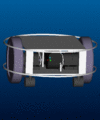|
.: Luke Cole - Home Page :.
(This site hasn't had many changes since 2013) (older version: lc.homedns.org 2003-2005) (long-standing biz: eteckonline.com 2001-2004, coletek.homedns.org 2005-2006, evolved to coletek.org 2007+) (other early online webapps here) |


|
MiC RobotWelcome to the home page for the MiC robot. MiC, pronounced "mick", meaning Mobile interactive
Computer is being developed as a cheap research platform for
advancements in robotics by research hobbyists. The mobile robot will
be upgradable and reconfigurable using DROS as the base software and
designed to fit ATX style motherboards.
Autonomous research and cost efficiency are the main concerns for the project. MiC is targeted for at the robotic hobbiest/researcher or the general hardware/programmer enthusiast wishing to explore controlling movable hardware or develop machine intelligence. 
Since MiC is designed for ATX style motherboards, primary electronics such computers are cheap. This also means it is easy to interface hardware such as Serial, Parport, USB since one can load and configure Linux with ease. Photos and Videos can be found here. DocumentationScopeMax Dimensions
Weight
Avg Velocity
Safety
Other requirements
Real-time ConcernsUsing Real-time Kernel: Specialised Kernel Space DriversRTLinux (or some other real-time kernel) is most definitly a solution to provide real-time performance. However this means programs rely on a specialise kernel, which make a real-time kernel an undesirable option. Using Standard Linux Kernel: User Space DriversRunning real-time required programs from user space would allow the use of the standard header files, however busy waiting problems would most probably make this option impossible for any real-time required programs. Using Standard Linux Kernel: Kernel Space DriversRunning real-time required programs from kernel space may cause the system to lock up if any modules contain bugs, futhermore debugging programs in kernel space can be difficult. However running the modules in kernel space will avoid busy waiting. Furthermore the Linux 2.6.x kernel provides an operating frequency of 1kHz (compared to 250Hz in 2.4.x), which can provide almost real-time performance when using the Linux scheduler. Available DriversBelow is a list (current very lonely) of Linux kernel space drivers to provide real-time performance using a standard Linux 2.6.x kernel: SoftwareDefault HardwareDrive Control System (Base Level)
Primary Electronics and Sensors
Alternative HardwareTrack Mechanism + Power Supply System
ResearchPrimary Research and Development
Secondary Research and Development
Future Research and Development
ContributionsDROS PeopleOngoing Robotic Operating System Project David Austin2004, Default Design Input and Machining Lance Cole2004, Machining Alex Talberg2000-2002, Base Track Mechanism Module
|
|||||||||||||||||||||||||||||||||||||||||||||||||||||||
|
© 2000-2025 Luke Cole All rights reserved |

